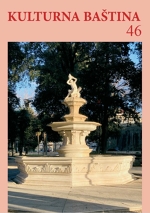KONZERVATORSKO-RESTAURATORSKI RADOVI NA TARČI HUSARSKOJ IZ 16. STOLJEĆA IZ MUZEJA GRADA SPLITA
CONSERVATION AND RESTORATION WORKS ON THE HUSSAR SMALL SHIELD – TARČA – FROM 16TH CENTURY
Author(s): Joško Bogdanović, Marta Kotlar, Sanja SerhatlićSubject(s): Museology & Heritage Studies, Visual Arts, Local History / Microhistory, 16th Century, Present Times (2010 - today)
Published by: DRUŠTVO PRIJATELJA KULTURNE BAŠTINE - SPLIT
Keywords: conservation-restoration; leather; metal; wood; shield; the hussar small shield - tarča;
Summary/Abstract: In 2019/ 20, a comprehensive conservation and restoration project was carried out on Tarča, a hussar small shield from the 16th century that is owned by the Museum of the City of Split. The procedure was entrusted to a team of experts, leather, metal and wood conservators-restorers, who are also lecturers and heads of the eponymous specialisations at the University of Dubrovnik Department of Art and Restoration. The procedure on skin was performed by Sanja Serhatlić, the one on metal by Marta Kotlar, while the works on wood were supervised by Joško Bogdanović. The perceived damage of Tarča could be described as a high degree of degradation of the wooden part of the shield, which was also a carrier of leather and metal. The damage was mostly caused by the action of insects and biological influences which were favoured by the climatic conditions of frequent oscillations of temperature and relative humidity. Xylophagous insects seriously impaired the stability of the wooden part of the shield while corroding the skin. The instability of the wooden part caused the loss of the iron spikes, which corroded the skin and wood. The paper addresses procedure in both chronological and conceptual manner. The procedure itself included analyses and identification of materials and diagnostic methods that helped in understanding the technique used in the making of the shield. All these findings were of key importance for the preparation of the proposal of works on the basis of which the conservation and restoration work was performed. In the main part of the paper, all the stages of the intervention are presented in a documentary manner, from disinsection, cleaning, stabilisation, consolidation, reconstruction, retouching and finally to the production of suitable protective packaging, all in accordance with the standards of the conservation and restoration profession.
Journal: KULTURNA BAŠTINA : ČASOPIS ZA PITANJA PROŠLOSTI SPLITSKOGA PODRUČJA
- Issue Year: 2020
- Issue No: 46
- Page Range: 333-372
- Page Count: 40
- Language: Croatian

